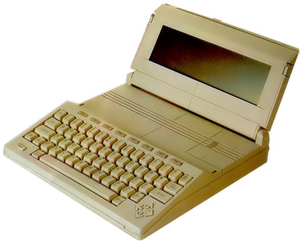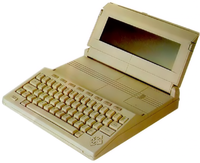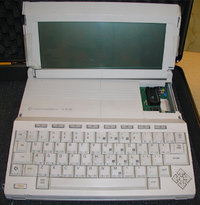Commodore LCD
| Commodore LCD | |
 | |
| Type: | Home and Business Computer |
| Producer: | Commodore Business Machines |
| Price: | Estimated 600 USD (1984 prices) |
| Released: | NA |
| Discontinued: | NA |
| Processor: | MOS Technology 65C102 |
| Memory: | 32kB (internally expandable with 64kB) (externally expandable with 64kB) |
| OS: | BASIC V3.6 |
| Info: | Also known as CLCD |
The Commodore LCD (abbreviated CLCD), is a prototype 8-bit computer with a Liquid Crystal Display (LCD) by Commodore Business Machines.
History[edit | edit source]
The CLCD was developed in late 1984 and first presented to the public at the January 1985 Consumer Electronics Show (CES) in Las Vegas. Following the break-up of the Plus/4 project teams, a number of personnel worked on minor projects that could be developed further. One of these was implementing an LCD screen. Commodore Semiconductor Group (CSG) had an optoelectronics division (at 4350 Beltwood Parkway South, Dallas, Texas, 75234) where research and manufacturing for LCD digital watches took place. In fact, this was the only LCD glass manufacturing company in the USA at that time. Along with portability, there was the intent to include a modem.
It is believed that Commodore’s CEO, Marshall Smith, spoke with the CEO of Tandy about the future of LCD products. When Smith was told that LCD would be going nowhere, he cancelled the project. With no need then for LCD technology, and no real calculator or watch production going on at Commodore, Smith sold-off the entire LCD division. There are rumoured to be 5 machines in existence, however only 2 are verifiable.
Contributors[edit | edit source]
Bil Herd worked on the initial architecture for the CLCD project and also designed the unimplemented MMU, before being moved to the team developing the C128. Jeff Porter, a self-confessed C64 hacker, from AT&T was the modem expert and became leader of the project team when Herd was moved. Ian Kirschman was a lead on the project. Hedley Davis, Judy Braddick, Andy Finkle, and Carolyn Scheppner were coders.
Concept[edit | edit source]
The CLCD was to be "a utilitarian computer for those of you who need a small, light, portable computer for use on the road, in the classroom, or simply in a remote room in your house"[1]. Jeff Porter has stated that he was recruited by Commodore to design "the machine you'd want for yourself" [2]. It was not meant to be a laptop computer, but more of a notebook computer.
Construction[edit | edit source]
| Table 1 - Construction of the CLCD | ||
|---|---|---|
| Aspect | Detail | Image |
| Dimensions | • Width: 11.75" (29.85 cm) • Depth: 11" (27.94 cm) • Height: 2.18" (5.54 cm) • Weight: 5 lbs |
 |
| Top Side | • Flip-up hinged LCD screen • Sliding cover for internal memory expansion • Mitsumi low-profile 72-key keyboard featuring: •• 8x function keys, F1 -F8 , non-shifted •• TAB , ESC , STOP , CAPS LOCK , 2x SHIFT , INST/DEL , CLR/HOME , RETURN • Arrow-shaped cursor keys • Power button |
 |
| Left Side | • Power Port +6V DC (unknown connector) • DTE/DCE jumper (DIN rail toggle switch) • DTR/Acoustic Coupler jumper (DIN rail toggle switch) • Acoustic coupler port • Phone port • Line port • Barcode Reader port (HP compatible) |
|
| Rear Side | • Contrast dial (rotary encoder) • Master Reset button • Expansion Port (50-pin male connector) • Master Reset button • Serial Port (6-pin DIN connector) • Centronics Port (IEEE 1284 36-pin male connector) • RS-232 Port (DB-25 female connector) |
|
Technical Specification[edit | edit source]
- Power:
- 4x 1.5V NiCd AAA batteries (5 hours of use)
- 6V DC
- Central Processing Unit: Rockwell 65C102 @ 1MHz
- Memory:
- Video: MOS Technology 8653
- Modes:
- 80 x 16 character location hires text mode in 2 colors (with a virtual screen of 80 x 25 character locations)
- 480 x 128 hires bitmap mode in 2 colors
- Although there was no external video output, Jeff Porter stated that "his team was thinking about a cartridge for the C=LCD which provided 80 column display for an external video display, using the C128's video chip"[3]
- Modes:
 |
 |
Chipset[edit | edit source]
Motherboard[edit | edit source]
| Chipset of the CLCD Motherboard | |||||
|---|---|---|---|---|---|
| PCB ID | Type | Manufacturer | Code No | Pins | Remarks |
| U1 | CPU | Rockwell | R65C102 | 40-pin DIP | |
| U2 | Gate Array | MOS Technology | 48-pin DIP | Possibly Video Display Controller (VDC) | |
| U3 | Gate Array | MOS Technology | 48-pin DIP | ||
| U4 | VIA | Rockwell | R65C22P2 | 40-pin DIP | |
| U5 | VIA | Rockwell | R65C22P2 | 40-pin DIP | |
| U6 | ACIA | Rockwell | R65C51P-1 | 28-pin DIP | |
| U7 | 28-pin DIP | ||||
| U8 | OKI | 16-pin DIP | |||
| U9 | Texas Instruments | 20-pin DIP | |||
| U10 | |||||
| U11 | 6-pin DIP | ||||
| U12 | 14-pin DIP | ||||
| U13 | Octal Buffer and Line Driver | Texas Instruments | SN74HC244N | 20-pin DIP | |
| U14 | 20-pin DIP | ||||
| U15 | 20-pin DIP | ||||
| U16 | Char ROM | 28-pin DIP | |||
| U17 | Hex Schmitt Trigger Inverter | Motorola | MN74HC14N | 14-pin DIP | |
| U18 | Programmable Quad Comparator | National Semiconductor | LP365N | 16-pin DIP | |
| U19 | |||||
| U20 | |||||
| U21 | |||||
| U22 | |||||
| U23 | |||||
| U24 | Quad 2-line Multiplexor | Texas Instruments | SN74HC157 | 16-pin DIP | |
Memory Daughterboard[edit | edit source]
| Chipset of the CLCD Memory Daughterboard | |||||
|---|---|---|---|---|---|
| PCB ID | Type | Manufacturer | Code No | Pins | Remarks |
| U101 | Texas Instruments | 14-pin DIP | |||
| U102 | ROM | Mitsubishi | M5M27C512AK-15 | 28-pin DIP | |
| U103 | ROM | Mitsubishi | M5M27C512AK-15 | 28-pin DIP | |
| U105 | ROM | Mitsubishi | M5M27C512AK-15 | 28-pin DIP | |
| U105 | ROM | Mitsubishi | M5M27C512AK-15 | 28-pin DIP | |
| U106 | ROM | - | 28-pin DIP | Empty | |
| U107 | EPROM | - | 28-pin DIP | Empty | |
| U108 | Texas Instruments | 14-pin DIP | |||
| U109 | RAM | 28-pin DIP | Expansion RAM | ||
| U110 | RAM | 28-pin DIP | Expansion RAM | ||
| U111 | RAM | 28-pin DIP | Expansion RAM | ||
| U112 | RAM | 28-pin DIP | Expansion RAM | ||
| U113 | RAM | - | 28-pin DIP | Empty | |
| U114 | Texas Instruments | 14-pin DIP | |||
| U115 | RAM | 28-pin DIP | Built-In RAM | ||
| U116 | RAM | 28-pin DIP | Built-In RAM | ||
| U117 | RAM | 28-pin DIP | Built-In RAM | ||
| U118 | RAM | 28-pin DIP | Built-In RAM | ||
| U119 | 28-pin DIP | Spare | |||
Software[edit | edit source]
The main menu offered a few utilities for copying from the internal RAM disk to an external drive, or for downloading over the built-in modem. On the ROM were a number of packages:
- Wordprocessor: A fully-featured word processor with justification options, search phrases, headers and footers, underlined and in bold text, centering, cutting and pasting, and storage. Operates in split screen mode.
- Spreadsheet: A-fully-featured spreadsheet similar to Microsoft's Multiplan.
- Terminal: A telecoms package, which works with the built-in built-in 300bps auto answer/auto-dial modem. It can send and download files, it has a buffer interception and auto-managing by phonecall be associated with a built-in address book. All parameters can be modified. It can emulate both the DEC VT52 & VT100 terminals.
- Memopad: A simple scratchpad program for making notes. It can be invoked while running other programs
- Calculator: Can be run in business, scientific and programmable formats. It includes hex and binary mode. The program can be invoked while running other programs
- BASIC: BASIC 3.6 is almost downward compatible with BASIC 7.0; however commands such as
COLORor system-specificPOKEs will not work. - Monitor: A machine language monitor which is similar to that found on the Plus/4. The 65C102 has new addressing modes for ten 6502 instructions and eight new instructions[4]:
Links[edit | edit source]
| Wikipedia: Commodore_LCD |
- Herd Dissects a Commodore LCD, accessed 10 Sep 2015.
References[edit | edit source]
- ↑ Commodore Microcomputers, March/April 1985, Volume 6, Number 2, Issue 34, page 74, accessed 01 September 2015
- ↑ Info-64, Issue 6, March 1985, accessed 04 September 1985
- ↑ MJK's Commodore LCD Page, accessed 5 September 2015.
- ↑ Filety, Online Magazine for the C64 Scene, accessed 5 September 2015

